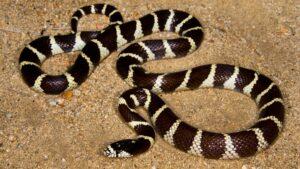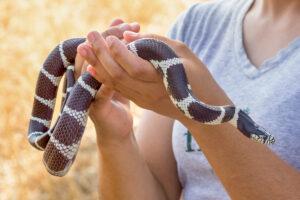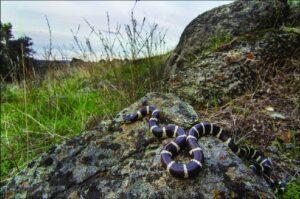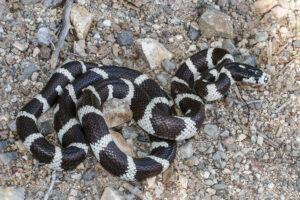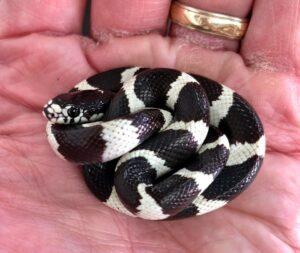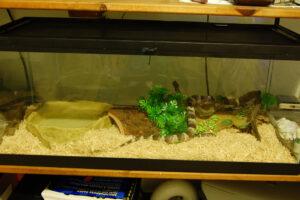The California kingsnake, is a colubrid native to the western United States and Northern Mexico. Being available in a wide range of color variations, easy to care for, and having a friendly, docile nature in captivity, it makes a good pet. It may be active at both day and night, depending on ambient temperatures. Brumation occurs during the winter months.
Scientific Classifications
- Suborder:Serpentes
- Family:Colubridae
- Genus:Lampropeltis
- Species:L. californiae
Conservation Status
Morphs
The California kingsnake is bred into over 50 known morphs. The most popular ones are listed below.
- High white
- High yellow banana
- Albino
- Lavender
- Chocolate
- Black and white striped
- Reverse stripe
- Desert phase striped
Description
Size
The full-grown snakes are 2.5-3.5 inches (76-107 cm) in size. Though they rarely exceed 48 inches (4 ft), those on Islas Angel de la Guarda, Baja California, Mexico, can get as big as 78 inches (2 m). The females are bigger than the males.
Color and Appearance
The species can come in a variety of colors in the wild. Usually, they have alternating dark and light bands that could range from black and white to brown and cream. Some have longitudinal stripes instead of lateral bands.
Are They Dangerous to Humans
If disturbed, the California kingsnake coils its body to hide its head, hisses, rattles its tail, and makes a sound similar to rattlesnakes. Nervousness leads them to twitch their tails. Though considered harmless to humans, on being handled, it usually bites, releases musk, and excretes.
California Kingsnakes at a Glance
Distribution
The California kingsnake’s range extends along the West Coast of North America to altitudes of around 6100 ft in the Tehachapi Mountains and over 7000 ft in the Sierra Nevada Mountains. They can be found in California, Oregon, Nevada, Utah, southwestern Colorado, northwestern New Mexico, Arizona, and northwestern Mexico. It is an invasive species in the Spanish island of Grand Canaria.
Habitat
A wide variety of habitats are home to the snake. They live in grasslands, woodland chaparral, marshes, deserts, and even suburban areas.
They spend most of the time on the ground but can occasionally climb bushes and small trees.
Lifespan
The California kingsnake lives for as long as 20 years.
Predators
Raccoons, hawks and other raptors, and skunks feed on it.
Diet
The opportunistic feeders eat rodents, amphibians, birds, and other reptiles. They prey on other snakes, including rattlesnakes as they are resistant to their venom. Their reptilian food habit has made them the strongest constrictors proportionate to their size. It is because reptiles need less oxygen to survive an attack than other animals like mammals.
Reproduction
Oviparous (lays eggs that hatch outside the body)
After their first shedding or hibernation, the snakes court in spring with the males competing for the available females. In course of the fight, a male can get onto another one and bite him to assert his dominance. The mating ritual starts with the male vibrating his body uncontrollably.
Between May and August, eggs are laid in a suitable location after 42-63 days of mating. A clutch typically has 5-12 eggs, averaging at 9 though they can have as many as 20 eggs or even more. The hatchlings that emerge after 40-65 days are around 8-13 inches in length.
Similar Species
Rattlesnake
Rattlesnakes are venomous and give birth to live young, unlike the California kingsnakes.
Care Sheet
Size of the Enclosure: Adults need to be housed in a 40-gallon wooden vivarium. The babies can be kept in a 10-gallon tank setup.
Temperature: The temperature should be maintained at 80°F during the day, with the basking spot kept at 90°F. At night it can drop to 72°F.
Humidity: The ideal humidity should be around 50% for the snake to shed properly. The terrarium should be misted twice daily to maintain the humidity level. It should also have a water bowl large enough for the snake to soak itself.
Substrate: The dry substrate can consist of aspen shavings, pelleted paper bedding, or cypress shavings.
Feeding: Its food should be frozen and thawed before consumption. Mice, lizards, and chicks can be fed to the pet. The hatchlings should be given a single prey item in a week, while the feeding frequency for adults should be 14 days.
Source
santacruzmuseum.org, cabidigitallibrary.org, researchgate.net, live.staticflickr.com, reddit.com, ball-pythons.net

